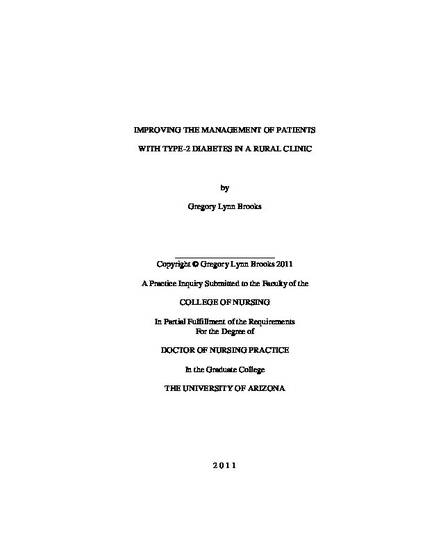
Dissertation
IMPROVING THE MANAGEMENT OF PATIENTS WITH TYPE-2 DIABETES IN A RURAL CLINIC
(2011)
Abstract
Background and Rationale: The increasing prevalence of type 2 diabetes, particularly in rural communities, is a major problem facing our nation. Many patients are in poor compliance with ADA guidelines for diabetes management. In addition, patients with diabetes in rural communities often face challenges that can impede management initiatives by health care providers (Utz, 2008). Quality care must be achieved to reduce the likelihood of costly, life-altering, and potentially fatal complications (American Diabetes Association, 2008). To manage chronic diseases effectively and prevent secondary complications, an organized quality review process within the practice setting should be in place to address quality indicators in an ordered and timely manner.
Purpose and Aims: The purpose of this project was to develop a quality improvement initiative (electronic diabetes education flow sheet - DEFS) associated with managing type 2 diabetes in a rural, nurse practitioner-managed clinic. The specific objectives were 1) to evaluate the extent to which select type 2 diabetes quality indicators are met; 2) to develop, implement, and evaluate a diabetes education process for a rural, nurse practitioner-managed clinic; and 3) to implement a QI framework clinic personnel can use for future QI initiatives.
Methods: The Plan-Do-Study-Act (PDSA) cycle was the framework used to implement the QI initiative. Process and outcome measures were collected for baseline data and the DEFS was developed. Routine evaluation by the QI committee ensured appropriate utilization of the DEFS. Patients receiving initial diabetes education were interviewed to understand their perspective of the education experience. For eight weeks, process data was reviewed to ensure improvements in diabetes education.
Results: Data analysis of process measures showed inconsistent documentation of selected quality indicators. Outcome measures were controlled 62% to 70% of the time. Clinical staff successfully integrated the DEFS into patient education and expanded its use to ensure compliance. Limited numbers of patient volunteers prohibited analyzing patient feedback on the education process.
Significance: This project demonstrated how QI initiatives can bring about positive changes in patient management. Based on this demonstration of how the PDSA cycle can be used to address clinical concerns, other rural nurse-managed clinics might use a similar method to implement QI initiatives to ensure quality healthcare.
Keywords
- Quality Improvement,
- Diabetes,
- Rural,
- Clinic,
- Primary Care
Disciplines
Publication Date
July 11, 2011
Degree
Doctorate of Nursing Practice
Field of study
Quality Improvement in Primary Care
Department
Nursing
Advisors
Deborah Vincent, Judith Effken, Cathy Michaels
Citation Information
Gregory L Brooks. "IMPROVING THE MANAGEMENT OF PATIENTS WITH TYPE-2 DIABETES IN A RURAL CLINIC" (2011) Available at: http://works.bepress.com/gbrooks/1/
